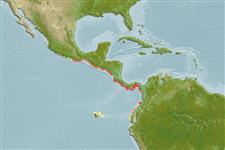Environment: milieu / climate zone / depth range / distribution range
Ekologi
marina bottenlevande; djupintervall 1 - 3 m (Ref. 11482). Tropical
Eastern Central Pacific: Costa Rica to Ecuador.
Size / Vikt / Age
Maturity: Lm ? range ? - ? cm
Max length : 4.5 cm TL hane/ej könsbestämd; (Ref. 11482)
Inhabits sandy or weedy areas (Ref. 11482). Feeds on invertebrates (Ref. 11482).
Life cycle and mating behavior
Maturities | Reproduktion | Spawnings | Egg(s) | Fecundities | Larver
Allen, G.R. and D.R. Robertson, 1994. Fishes of the tropical eastern Pacific. University of Hawaii Press, Honolulu. 332 p. (Ref. 11482)
IUCN Red List Status (Ref. 130435)
Threat to humans
Harmless
Human uses
Verktyg
Special reports
Download XML
Internet-källor
Estimates based on models
Preferred temperature (Ref.
123201): 26.9 - 29.1, mean 28.2 °C (based on 110 cells).
Phylogenetic diversity index (Ref.
82804): PD
50 = 0.5000 [Uniqueness, from 0.5 = low to 2.0 = high].
Bayesian length-weight: a=0.00490 (0.00196 - 0.01224), b=3.09 (2.87 - 3.31), in cm total length, based on LWR estimates for this (Sub)family-body shape (Ref.
93245).
Trofisk nivå (Ref.
69278): 3.5 ±0.37 se; based on food items.
Fishing Vulnerability (Ref.
59153): Low vulnerability (10 of 100).
